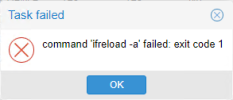Hello Guys!
I'm setting up our new cluster at the moment.
The cluster network is a 25 GBit Full-Mesh configuration between the nodes (up and running! ;-) )
To follow the KISS principle and reduce the point(s) of failure I thougt about a second mesh for corosync (with fallback over public network).
The configuration of the cluster network looks like that (node 1 as example):
frr defaults traditional
hostname prox01
log syslog warning
ip forwarding
no ipv6 forwarding
service integrated-vtysh-config
!
interface lo
ip address 10.10.11.101/32
ip router openfabric 1
openfabric passive
!
interface enp65s0f0np0
ip router openfabric 1
openfabric csnp-interval 2
openfabric hello-interval 1
openfabric hello-multiplier 2
!
interface enp65s0f1np1
ip router openfabric 1
openfabric csnp-interval 2
openfabric hello-interval 1
openfabric hello-multiplier 2
!
line vty
!
router openfabric 1
net 49.0001.1111.1111.1111.00
lsp-gen-interval 1
max-lsp-lifetime 600
lsp-refresh-interval 180
Is is possible to set up a second full mesh an the same nodes for Corosync?
Thanks in advance.
itiser
I'm setting up our new cluster at the moment.
The cluster network is a 25 GBit Full-Mesh configuration between the nodes (up and running! ;-) )
To follow the KISS principle and reduce the point(s) of failure I thougt about a second mesh for corosync (with fallback over public network).
The configuration of the cluster network looks like that (node 1 as example):
frr defaults traditional
hostname prox01
log syslog warning
ip forwarding
no ipv6 forwarding
service integrated-vtysh-config
!
interface lo
ip address 10.10.11.101/32
ip router openfabric 1
openfabric passive
!
interface enp65s0f0np0
ip router openfabric 1
openfabric csnp-interval 2
openfabric hello-interval 1
openfabric hello-multiplier 2
!
interface enp65s0f1np1
ip router openfabric 1
openfabric csnp-interval 2
openfabric hello-interval 1
openfabric hello-multiplier 2
!
line vty
!
router openfabric 1
net 49.0001.1111.1111.1111.00
lsp-gen-interval 1
max-lsp-lifetime 600
lsp-refresh-interval 180
Is is possible to set up a second full mesh an the same nodes for Corosync?
Thanks in advance.
itiser
Last edited:



